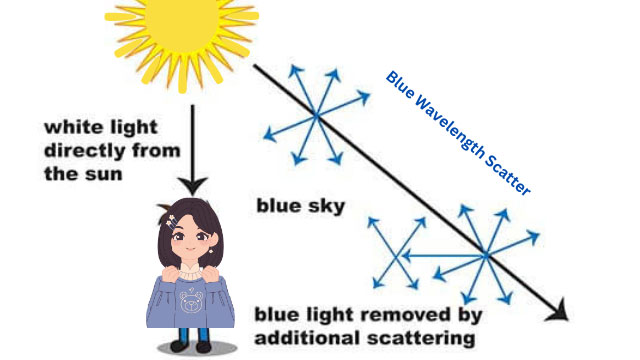
As the sun dips below the horizon or crests the dawn sky, a breathtaking transformation occurs: the sky is set ablaze in shades of red, orange, and pink, painting a masterpiece that has captivated humans since time immemorial. But what orchestrates this celestial spectacle, turning the sky into an artist’s canvas at the beginning and end of each day? The phenomenon of the sky turning red at sunrise and sunset is not just a daily dose of natural beauty but a fascinating scientific puzzle that involves the journey of light through the Earth’s atmosphere.
Sunlight looks bright and clear, but it’s made of multiple colors called the color spectrum, and they combine to produce white light. The sunlight or white light is a mix of all the rainbow colors. A rainbow is the visible color of the spectrum, all separated. Each color in the spectrum has a different wavelength. Some light travels in short waves, while others travel in long ways.
Also, light travels from the sun to the earth. It has to travel through the Earth’s atmosphere. The atmosphere we live in, called the troposphere, comprises oxygen, nitrogen, and other molecules like water vapor. The Sun is close to the horizon at sunrise, night, and sunset. So, the sunlight travels a large distance in the Earth’s atmosphere. Red light is scattered the least, and blue and green light gets scattered more. Due to the large wavelength, red light scatters less. So it reaches our eyes, which is why the Sun appears red at sunset and sunrise.
In this post, we will dive into the atmospheric phenomena that create these vivid hues, exploring the interplay of light, air, and particles to unveil the secrets behind the sky’s most mesmerizing moments. Join us as we chase the sun across the sky, uncovering the reasons behind its fiery farewell and welcome.
Why is the sky red at night, sunrise, and sunset?
The sky appears red at sunrise and sunset due to atmospheric scattering. Here’s a simplified explanation of why the sky can turn red during these times:

Sun’s Position: During sunrise and sunset, the sun is lower on the horizon compared to midday when it is higher in the sky. This means sunlight has to pass through a larger portion of the Earth’s atmosphere.
Increased Path Length: When sunlight travels through a larger portion of the atmosphere, it encounters more air molecules and particles. This longer path length causes more scattering of shorter wavelengths (blue and green) and enhances the transmission of longer wavelengths (red and orange).
Rayleigh Scattering: Rayleigh scattering occurs when light interacts with molecules in the atmosphere, causing shorter wavelengths to scatter more. During sunrise and sunset, the blue and green light is scattered away from our line of sight, leaving predominantly longer wavelengths to reach our eyes.
Red Light Dominance: As the shorter wavelengths are scattered away, the remaining longer wavelengths, particularly red and orange, become more visible. This dominance of longer wavelengths contributes to the red, orange, and pink hues observed during sunrise and sunset.
Particle and Dust Effects: The presence of particles, dust, and pollutants in the atmosphere can further enhance the scattering and filtering of light during sunrise and sunset. These particles can scatter and reflect sunlight, adding color effects and intensifying the red hues.
Atmospheric Conditions: The quality of the air, humidity, and the presence of clouds can also influence the appearance of the sky during sunrise and sunset. Moisture and particles in the atmosphere can scatter and refract sunlight differently, creating variations in color and intensity.
The light from the Sun enters our atmosphere and is scattered about the air. The air is filled with nitrogen, oxygen, argon, water vapor, and particles like smoke, ash, pollution, etc. These gases serve as filters or prisms to give us different types of light. The rainbow of colors that make up light blue and purple are scattered.
Scientific Explanation
The sun is closer to the horizon, meaning the light has to travel far from the atmosphere. Long wavelengths give us red and orange colors, whereas short wavelengths give us blue and indigo colors. When sunlight hits these atmospheric molecules, it bounces off them and gets scattered in all directions. It’s called Reilley Scattering.
The scientific reason is they have the shortest wavelength. The other colors can make it pass all those bumps in the atmosphere. The bumps are nitrogen, oxygen, water vapor, etc. At noon or midday, the Sun is high in the sky, and light doesn’t have that far to travel to our eyes.
So, not all of the blue light is scattered, and that’s why the sky is blue, but at sunset, the light has to travel ten times more atmosphere. We see the long wavelengths of light and the short wavelengths of blue are scattered out. That’s why we see the yellow, orange, and red colors.
During the autumn equinox, day and night are equal. Then, each day gets shorter as the sun’s rays approach the northern hemisphere at a more extreme angle. The southern hemisphere is starting to get the more direct Sun, but a more extreme angle in the northern hemisphere. It means that now the light from the Sun has to travel even farther at sunset to make it to our eyes. There’s a better chance that more blue light will get scattered out during that trip and a better chance that we’ll see a yellow, orange, or red sunset.
What causes the red sky at night? A good sunset depends on the atmosphere’s high pressure because it squashes all those gas molecules. So you get more blue light scattered and red light hitting your eye. It’s going to travel overnight eastwards.
Why are the colors of fall and winter sunsets so vivid? During the fall in winter, the weather patterns allow for dryness. It means with clean air, the spectrum of colors makes it through without getting scattered by those particles in the air. You would have seen some pretty spectacular sunrises and sunsets where the sky is on fire, and the colors are vivid. How does that happen? The best way is for the air to be fairly clear for brightly colored sunrises and sunsets.
Experimental explanation by physics: Here in the picture, we have a converging or convicts lens L1. A strong white light earth source is kept at this converging lens’s focus. The cardboard, there is a hole in it. So, after refraction, we will get the parallel beam of light.

The parallel light beam passes through this transparent glass tank containing clear water. When it falls on the cardboard, only a few rays can pass through this hole because all other parts do not allow the light to pass to the site. So some rays of light pass through this hole.
We have another converging lens, another convex lens, which converts these parallel raids onto the screen. Take about 200 grams of sodium sulfate and Heibel, and dissolve in about two liters of clean water in the tank. Guess what? First, it was pure water, but now the sodium mixture also fits with water in two liters of clean water. Then, we add about one to two milliliters of concentrated sulfuric acid to this water.
Then, the fine microscopic sulfur particles start precipitating in the tank in about two to three minutes. As the sample particles form, we can observe the blue light from the glass tank’s three sides because of scattering.
So when the beam of light passes through this glass tank, the fine sulfur particles precipitated in the glass tank scatter the light of short wavelengths such as blue light—because of that, scattering by the colloidal sulfur particles. We observe the blue light from the three sides of the glass thing from this side and then decide which side is opposed.
So, when you observe the color of the transmitter light from the glass’s forward side, it is from this site facing the circular hole. We will observe at first an orange-red color. We will observe bright crimson-red colors on the screen.
Quiz: Why does the sky red during sunset, sunrise, and night?
a) Due to the reflection of light.
b) Refraction of light.
c) Dispersion of light.
d) Scattering of light.
The correct answer is it’s due to the scattering of light.
Our expedition through the changing colors of the sky as the sun rises and sets has brought us to a deeper understanding of this daily marvel. We’ve seen how the interplay of sunlight with the Earth’s atmosphere creates the stunning reds, oranges, and pinks that adorn the horizon at dawn and dusk. This journey through the science of sunsets and sunrises reminds us of the profound beauty inherent in the natural world, a beauty that is as much a part of the laws of physics as it is a source of inspiration and wonder.
As we part ways with the setting sun or greet its rising glow, let us carry with us the knowledge of why the sky paints itself in such extraordinary colors and the reminder to pause and appreciate these moments. May every red sky at night or morning serve not just as a shepherd’s delight but as a call to marvel at the intricate dance between light and the canvas of our atmosphere. So, the next time you witness the sky ablaze in red, remember the beautiful complexities behind this celestial display, and let it inspire you to explore further the wonders of our world.
Learn more:
References:
Van Flandern, T.; K. Pulkkinen. “Low precision formulae for planetary positions.” Astrophysical Journal Supplement Series.
Yu Timofeev & A. V. Vasilʹev. Theoretical Fundamentals of Atmospheric Optics. Cambridge International Science Publishing.
Craig F. Bohren & Eugene Edmund Clothiaux. Fundamentals of Atmospheric Radiation: An Introduction with 400 Problems. Wiley-VCH. p. 427.
David K. Lynch; William Charles Livingston. Color and light in nature. Cambridge University Press.
National Weather Service. “Chapter 3: Radiation and Temperature”. Anchorage, Alaska: NOAA.
Darula, S.; Kittler, R. “General Sky Standard Defining Luminance Distributions.” Proc. Conf. eSim 2002. Montreal.
Nave, C. R. “Red Sunset, Green Flash.” Georgia State University. HyperPhysics.
